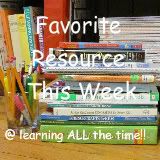 Hi, I'm Heidi and I homeschool my two sweet kids. I want them to know that learning is an exciting lifelong adventure! We love great books, unit studies, notebooking, lapbooking, and hands-on learning.
Hi, I'm Heidi and I homeschool my two sweet kids. I want them to know that learning is an exciting lifelong adventure! We love great books, unit studies, notebooking, lapbooking, and hands-on learning.Our Homeschool Journal: Lucky Finds
In our homeschool this week…
I didn’t get much that I had planned accomplished this week, but it was mostly due to some great luck. We acquired some amazing things for our homeschool this week for very little money. That’s the luck part. The only not-so-lucky part: our schoolroom now looks like a tornado hit…and spread debris throughout the whole house. I’m not complaining, though, because these items (some of which were on my wish list, some of which I didn’t even know I wanted!) are now ours:
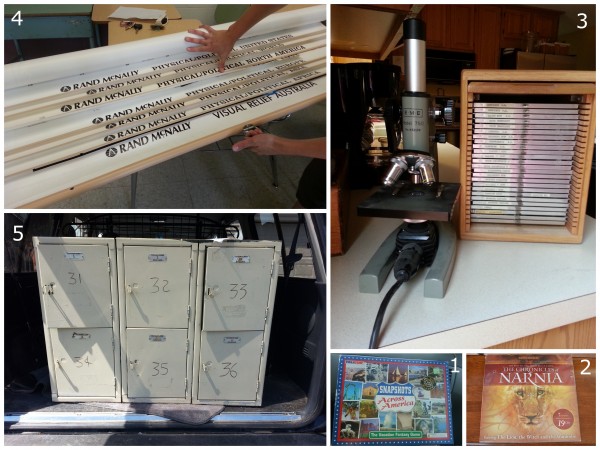
- Snapshots Across America: a game I’d had on my Amazon wishlist since a friend told me about it. Learning about U.S. geography and famous places with a game? Perfect. Finding it at Goodwill for $1.00? Lucky. The only thing it was missing was directions, and after I emailed the company, Talicor, they kindly emailed them to me.
- Focus on the Family Radio Theatre of the complete Chronicles of Narnia: basically free. No, don’t hate me. Our library has an amazing summer reading program where the kids earn book bucks to “spend” at a celebration at the end of the program. I easily persuaded my daughter to have this be one of her choices.
- Microscope and a box of slides: a town in our area built a brand new high school and had a yard sale at the old one. It was great fun–they’d walk you through the old building and you could just make offers on anything not nailed down: we scored these for $20.
- Roll-down maps: this was the item I was actually hoping to find. After seeing how Tricia at Hodgepodge used them as window blinds I really wanted roll-down maps. We don’t have much wall space left in our schoolroom so it was the perfect solution. I saw these on a wall in one of the classrooms, and they were mine for $5.00. Seriously! Never mind it took us half a day and around $30 to hang them–it is still an amazing find.
- Lockers: who knew I needed these? For $10 these are going to be a fun addition to our schoolroom. I had to make some major furniture adjustments to accommodate these, but I just couldn’t pass them up.
Places we went and people we saw…
We did do some of what I planned–the first was attending an airshow at Owl’s Head Transportation Museum.

That same day we also checked another Maine lighthouse off our list!
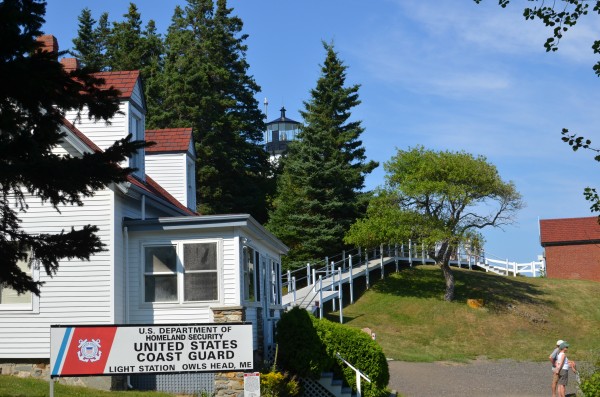
And said goodbye to some little friends we’d become pretty attached to (full post on the Monarch butterflies later).
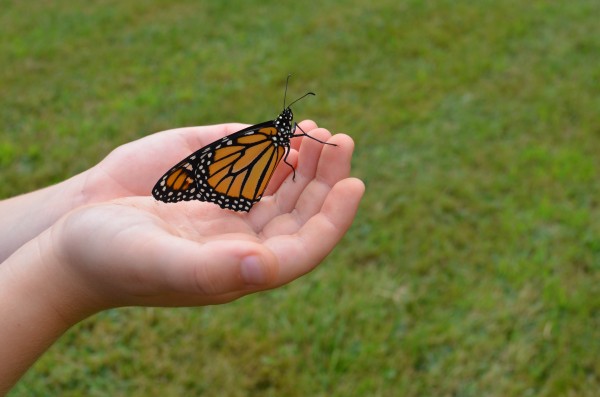
Things I’m working on…
So my almost-ready-for-the-new-school-year schoolroom is now completely torn apart. But it will all be worth it. I’m telling myself that as I am doing this:
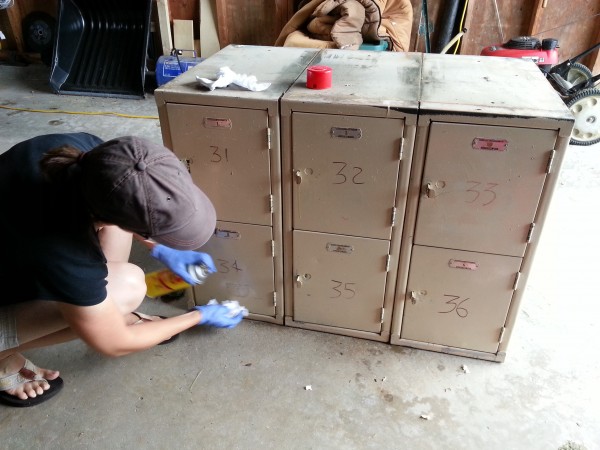
I’m grateful for…
My husband. I was feeling overwhelmed, partly because my priorities were getting out of order. We went for a walk and I blabbered on and on and he kindly and gently reminded me of what mattered most and how much he valued my role in our family. After his pep talk I felt completely renewed. He is an amazing man, and I don’t know what I would do without him.
Thank you to the wonderful hostesses with fun link-ups on Fridays. Be sure to join the fun and see what other homeschoolers are up to!
2012-2013 ~ Curriculum and Plans
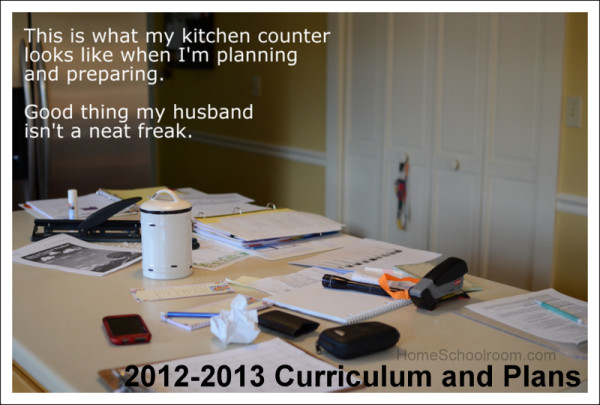
Well, here they are–my plans, dreams, and aspirations for the upcoming school year. And even though I love lists, I do try to make them in pencil and reserve the right to change them as needed!
Big Sister’s Fourth Grade Individual Work:
- WriteShop Junior D: This is a new curriculum for her and I’m very hopeful that it will be a great fit. She’s excited because it’s writing, an activity she loves, and that we’ll be working one-on-one for the lessons. There are three main goals I have for her with this program: a better understanding of paragraph structure, being able make an outline to organize her thoughts before she writes, and working on grammar within her own writing.
- All About Spelling: This curriculum was one of the hits from last year, though I would say we didn’t utilize it frequently enough to attain the full benefit. I started at level one as the program recommends and she could have gone through it much more quickly if we’d used it as often as recommended. We both liked it, though, and we’ll be diving in this year. I am planning to combine this with our work in WriteShop and block out a chunk of one-on-one language arts teaching time with her three times a week. With a year of experience under my belt and a more independent younger brother I think I can make this happen.
- Cursive Handwriting: She is capable of writing legibly in cursive, the goal now is to smooth it out and increase her speed so she can fully transition. She will be doing copywork in cursive that goes along with our history program, and I will also make more as needed using excerpts from literature we are reading and a free front called School Script Dashed.
- Math: We will continue to use Khan Academy as her math curriculum. I wanted to be sure it was the right choice for us so I did quite a bit of research over the last month. I was sure I wanted a computer-based curriculum that did not require me to plan and teach a lesson each day. After looking at all the option Khan still came out ahead for us–with the added bonus that it’s free. She enjoys the program, and with me or my husband nearby to help with any questions it works well for us. I keep an eye on the mathematics requirements in our local public school district, the Common Core standards, and Home Learning Year By Year by Rebecca Rupp to be sure she covers all necessary topics. We’ll continue to cement all math facts using XtraMath and I also have her play math apps for 10 minutes each day to work on multiplication facts. Edited to add: Okay, so plan A for math did not work at all. Short Story: we switched to Teaching Textbooks. Long story can be found in this post: Our Switch to Teaching Textbooks.
- Music: She continues in private piano lessons each week with a minimum of 30 minutes daily practice.
- Typing: She will use TypingWeb, a free web-based typing program to further her typing skills. The goal? That she can type her own stories since she can write fairly long ones!
Little Brother’s First Grade Individual Work:
- Funnix: Funnix is a computer-based learn-to-read program that is working very well for him, and I am very proud of our beginning reader! He will continue to progress through the lessons and on days we don’t do a lesson from Funnix I have him read from any beginning reader book he can tackle. Handwriting and spelling are all included in the lessons.
- Math: This was a tough subject to plan. He does not do well with a worksheet-based curriculum, which we tried last year, nor is he old enough for computer-based programs. I will use the same references I use for his big sister to determine the topics he needs to learn and we’ll tackle one skill at a time, approaching each topic in a way that suits him. It may be a hands-on game, it may be an iPad app, it may be cooking or building…this isn’t necessarily the easiest route but it’s what works best for him. (For more on this you can read my post about teaching coin recognition.)
Together Studies:
- History: We started work on Time Travelers Early 19th Century from Homeschool in the Woods. The printables (minibooks, notebooking, maps) and activities are terrific. We’ll spread this history unit study over the first half of the school year, reading lots of living books and finding documentaries to supplement.
- Science: We also started a science curriculum this summer–R.E.A.L. Science Odyssey Life Level One. It is also working well and we will continue into the school year. You can read my full review of R.S.O. We’re working on the animal kingdom now, then we’ll be slowing down as we get to the human body and really diving into that topic. I had been preparing a human body unit study (due to great interest from my son) before I received this curriculum so we’ll use R.S.O. along with other materials I’d gathered.
- Nature Study: One of the most enjoyable parts of our homeschool. We use ideas from Barb at the Handbook of Nature Study, participate in her Outdoor Hour Challenges, and also follow any interest-led nature study topics.
- Unit Studies: We will fit in unit studies as we go along based on holidays, special events (like a presidential election) and interest. I know that I want to do one on government and elections in October, and we take a break from most of our regular schoolwork in December to focus on Christmas topics.
- Other Activities: both children participate in Scouts, we will now have weekly meetings with our homeschool bookclub that met once a month last year, and big sister is in a youth group at church.
Well, it sounds like we’ll have plenty to keep us busy! The funny part is, I keep trying to plan more. I would like to incorporate composer and artist studies and am considering Harmony Fine Arts plans. I also would like to dabble in some foreign language fun–nothing too expensive or time intensive just now. But I am going to let us get rolling into our year and be happy to add/subtract and make any adjustments as we go along.
I’m linking up at the iHomeschool Network’s Not Back to School Blog Hop. Pop over there to take a peek at other homeschoolers’ plans!

Review: R.E.A.L. Science Odyssey Life Level One
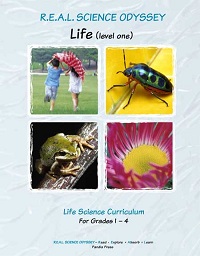
Though not everyone views a formal science curriculum as necessary for children in early elementary years, I have a six year old son who loves all things science. We already did a lot of reading science books and watching scientific shows, but I wanted to spend more time on science in our homeschool and be sure I was covering basic building blocks of science knowledge for both him and his 10-year-old sister. I was excited to receive a copy of R.E.A.L. Science Odyssey Life Level One curriculum from Pandia Press to review. I had seen this curriculum online and was interested in seeing if it would be a good fit for our family.
What is it?
R.E.A.L. Science Odyssey is a science curriculum from Pandia Press. R.E.A.L. stands for read, explore, absorb, and learn. Life Level One is a full year of life science designed for grades 1-4. Each unit consists of a read-aloud lesson page followed over the course of the week (or longer, if needed) by hands on activities and labs that reinforce that lesson. There are student pages for your children to record what they’ve observed and the results of lab activities.
What works for us:
- The text for the lesson is not like a dry textbook, but more like a fun conversation with your cool scientist neighbor. The lesson page is informative but short and interesting enough to hold even my six-year-old’s attention.
- As a fan of Charlotte Mason and lover of good books I really appreciate the list of additional reading suggestions. It is especially handy because it marks which books are highly recommended versus just “more fun than science.” I attempt to request most of these from our library and feel it is a good supplement to the lesson text pages in the curriculum.
- The best part of this curriculum, and the reason it’s a great fit for our family, are the hands-on activities. Very little time is spent with me just talking to my kids about science, much more time is spent showing and doing and trying. As a line in the curriculum’s introduction states: “If you hate to touch “bugs,” wouldn’t think about letting your child handle worms and have no intention of getting gooey and dirty, RUN NOW!” You’ll be asked to bring critters into your home, build models, act out life cycles, and test different functions of your body. Many of the activities are easy to implement and may seem simple, but doing things really cements knowledge for my children.
What doesn’t work for us:
- We don’t usually use worksheets, so some of the printed pages intended for the student to fill out don’t work well for us. I skip the pages that include coloring or labeling the parts of a existing drawing, or simply have fill-in-the-blank questions. Drawing encourages my children to look carefully and pay attention to details. Many pages do have the child make a drawing of an observation and I use those, or if I skipped the included worksheet I simply give my children a blank piece of paper. If I had to estimate I would say I’m able to use roughly 80% of the student pages. Having the building blocks of science covered and hands-on learning activities planned out for me far outweighs not liking some of the printables.
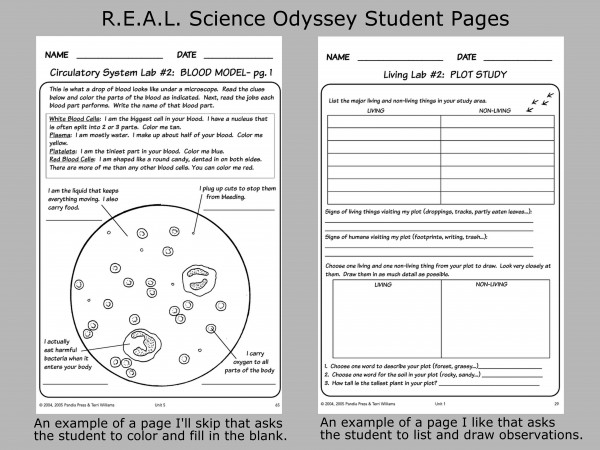
- There are hand-drawn illustrations, but no real photos. In many instances you’ll be going outside to look for worms or a flower instead of needing a picture, but there are many items we don’t have easy access to. Internet searches or additional books will fill in the gap.
- I had to rearrange the order of the lessons. If we had done them in order we would have labs requiring worms, butterflies or other creatures from outside when in Maine the outside is buried in snow. I was nervous about this since the introduction discussed how the curriculum was meant to be used from start to finish with concepts building on one another, but I found it fairly simple to rearrange. The units are laid out this way: an introduction to the basis of life, then a study of the human body, followed by a study of the animal kingdom and then the plant kingdom. We did the introduction and moved into the animal kingdom (the last phylum covered is mammals), then we’ll spend much of the winter on the human body, and finish up with the plant kingdom in the spring when we can actually find signs of life outside.
The bottom line:
If you’re looking for an elementary level science curriculum that involves a lot of hands-on learning R.E.A.L. Science Odyssey may work for you. My kids are learning a lot and enjoy the activities. It’s simple to implement with easy-to-understand text and clear instructions for all labs and activities. Suggestions for supplemental books and websites are already included. This is a secular science curriculum, but other than a list of books covering evolution in the additional reading suggestions I didn’t find topics in this curriculum that would cause problems for Christian homeschoolers.
Check it out for yourself!
Pandia Press shows several preview pages for RSO Life Level One on their website, and there is also a larger preview to download. You can purchase the ebook directly from Pandia Press, or they have a list of retailers that sell the print version. I received the ebook and found it quite easy to use, with the added benefit of being able to print a copy of the student pages for each of my children.
Our Homeschool Journal: Lighthouses, Laundry, and Lists
In our homeschool this week…
We didn’t do a lot of formal schoolwork this week, which is okay because I didn’t plan a lot of schoolwork! We had a camping trip and then I knew I needed planning time. We spent three days camping, then three days catching up on laundry. (At least that’s what it feels like!) At home I spent time checking items off my list of things I had to finalize for our 2012-2013 school year. We did an hour of schoolwork here and there, accomplishing a lot of reading and even a little math, history and science. Of course, it seems that everywhere we go learning opportunities follow.
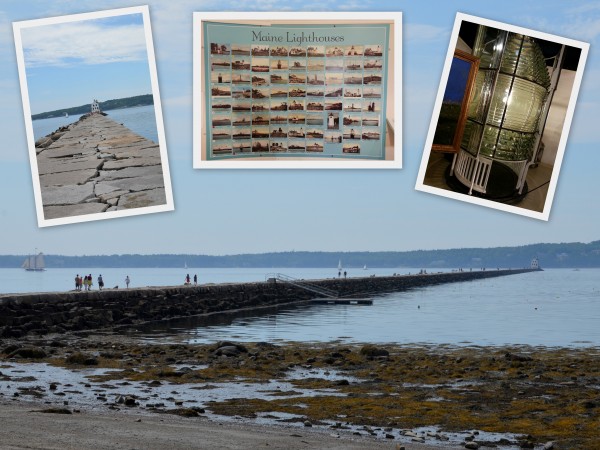
Places we’re going and people we’re seeing…
The area where we camped had another one of those great free summer-in-Maine activities! We walked the nearly mile-long trek out to Rockland Breakwater Lighthouse. Visiting lighthouses is a little hobby for us and we’ve taken our kids to quite a few. (Very Maine-ish, don’t you think?) I think it’s fun to pick something your area is known for and visit those places–like a tourist in your own state. My kids get even more excited to go to a lighthouse because it’s a quest to visit a new one we’ve not seen before. We also visited the Maine Lighthouse Museum (and bonus–it was free admission day!), a treasure trove of information–explanations, videos, and displays on the Fresnel lens and other aspects of a working light and foghorns, historical information on lighthouses and their use in navigation, and my favorite: the stories of the keeper’s lives and job requirements.
My favorite thing this week was…
Camping is my favorite summer activity, and special time with Grandma and Grandpa for my kids made it extra special.
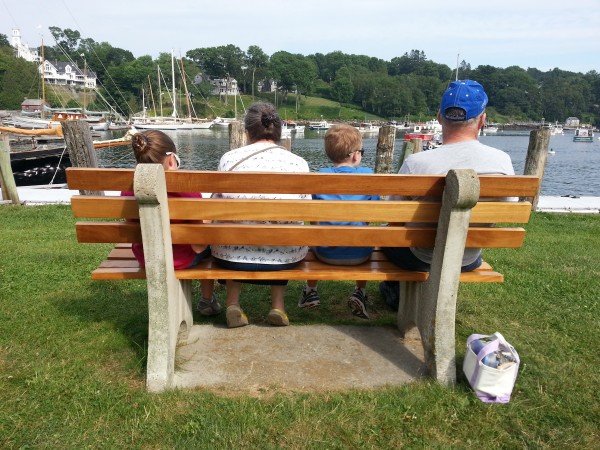
My favorite resource this week…
Last year we used a downloaded typing program with our 10-year-old with some success, but due to the operating system on the computer she’s using we needed another plan this year. I was happy to find a free web-based learn-to-type program: TypingWeb. In our early trials she and I are both quite happy. That’s one more thing checked off on my planning list!
What’s working and not working for us…
Taking the time to sit down and finalize my plans is working for me. It helps me feel relaxed to enjoy our last weeks of light summer learning and be ready to dive into our full-time schedule in September.
Questions I have…
My last thing to figure out is a morning meeting. I want to have a morning routine that doesn’t leave me feeling scripted and too school-ish like the calendar time I tried last year. I stopped that mid-year, but feel like we do need a little time together before starting individual work. I would like to find a devotional book to use with the three of us together…any suggestions?
Things I’m working on…
I’m working on the last pieces of planning. I’m at the point where I’m figuring out our daily and weekly schedules. I have an idea for a weekly schedule for my 10-year-old as we work toward more independence. We’re ironing out the details with our homeschool groups on some classes and groups for the new school year.
I’m grateful for…
All the amazing resources (often for free) at our fingertips as homeschoolers in the age of computers and internet!
A photo to share…
On our trip we ate at a quirky little restaurant with delicious food in Rockland. After seeing this menu item–check out the first one under lunch specialties–I just had to take a picture. I really wanted to say to the waitress: “Yes, I’ll take Home Schooled, please.”

Thank you to the wonderful hostesses with fun link-ups on Fridays. Be sure to join the fun and see what other homeschoolers are up to!
Last Child in the Woods ~ Changes for the Future
I’m here with more thoughts on the book Last Child in the Woods by Richard Louv, joining in Nicole’s book study. Be sure to visit her at Journey to Excellence for her thoughts on these chapters and the big changes her family is making.
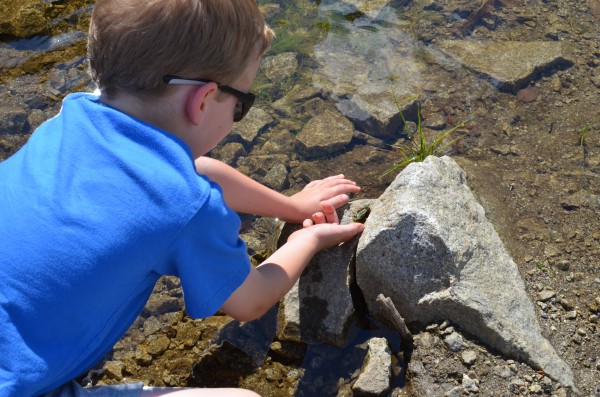
Chapters 18 through 20 in the book discuss ushering in the “fourth frontier” and reconnecting not just ourselves but our culture with nature. These chapters have very big, far-reaching goals that really involve a restructuring of how people live. The author’s point is that we can connect our kids with nature right now, but we need to make changes to our culture or the child-nature gap will continue to widen. I agree, but changes in population distribution sounds too orchestrated to me. I enjoy living in a rural area. If we were moving I would be interested in towns with a big connection to nature. But can you force those interests on the population as a whole?
I’ll admit this: he loses me a bit in these conversations. I tend to think small and change what I am in control of, versus getting involved in larger organizations. I pulled my kids out of school instead of working to change the school system. I was very excited to read the ideas for reconnecting myself and my children with nature that are within my immediate control–things I can implement on my own right now. But when the author talks of sweeping changes in the structure of towns and cities and businesses I feel more overwhelmed than able to help. Clearly there are movers and shakers who get involved in politics and organizations that make sweeping changes, and I’m grateful for them and benefit from the work that they do…but I’m not one of them.
In the discussions of cities he talks of making nature corridors, not just isolated parks that don’t look natural at all. The discussion of allowing movement and genetic diversity did hit home for us: we’ve been studying monarch butterflies and their amazing migration. They need milkweed plants as they migrate north from Mexico in the fall. If they don’t have milkweed plants to lay their eggs on in the southeast, we won’t have monarch butterflies in the summer in the northeast. My plan of action is growing my own milkweed patch, doing my small part. But I do hope the movers and shakers, like the Monarch Watch organization, are successful in protecting these amazing creatures.
Another small part I have been learning about for a while now as a gardener is using native plants that are less resource intensive. I live in a manicured neighborhood and am one of the very few that doesn’t spray my lawn with chemicals. It shows–my lawn is probably 50% clover and dandelions and other “weeds” BUT I haven’t suffered from the grub damage (grubs eat grass roots, not weed roots) of my neighbors with perfect lawns. I also have one of the greenest lawns right now because my weeds are surviving the drought much better than the grass of my neighbors. The reason I don’t spray: my kids and dog can play on it anytime without fear of chemical exposure.
In short, these chapters had interesting ideas, but didn’t give me ideas for implementation in my daily life. There are just three chapters left in the book. Join us for the last installment in this book study later this week or early next week.
Nature Study ~ Mesmerized by Monarch Metamorphosis
I really wanted to raise caterpillars into butterflies for the kids to watch. I really wanted them to be monarch caterpillars. We’d done it years ago and the amazing process is still etched in my mind but even my 10 year old’s memory of it is fuzzy. The caterpillar is striking and not hairy (my son got hives from a hairy caterpillar last year so both my kids now refuse to touch any caterpillars with hair), the chrysalis is like a jewel, and the butterfly is beautiful. The problem: I couldn’t justify the $26 in shipping charges to order monarch caterpillars.
I was determined and, after looking at countless images online felt I could recognize milkweed–the only food monarch caterpillars will eat. This was one of those times when my husband just shook his head, because he knows I get an idea in my head and can’t let it go. He chuckled as I looked into roadside wildflowers on our walks and in the car. I took my family on some crazy back-road drives until I found a country road with tons of milkweed…and I went searching. Here’s me up to my waist in a field of milkweed, searching for teeny-tiny caterpillars. I would have been happy with eggs, too, but since they’re the size of the head of a pin I decided that just might be impossible. My family cheered me on from inside the bug-free car as I battled the mosquitos.
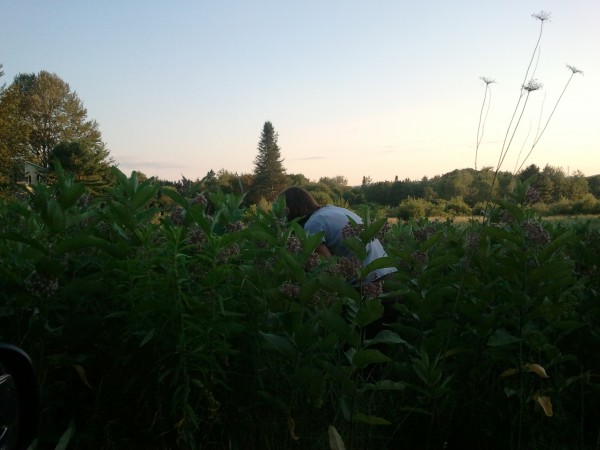
Finally–success! Two monarch caterpillars came home with us. The smallest one (dubbed “Little Guy”) was so tiny he was still whitish with a dark head. “Big Guy” was already getting the striped pattern characteristic of monarch caterpillars. We set them up right in the middle of our kitchen island. Yup, we’re homeschoolers.
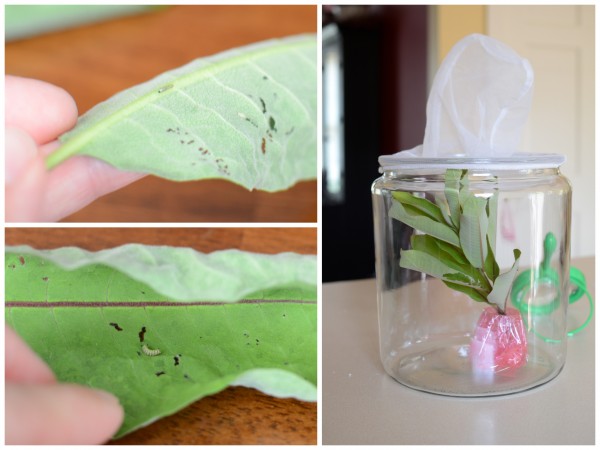
It was amazing how fast they grew! We had several opportunities to watch them molt. We were in awe of how much they could consume in a day, and how much frass (new vocabulary word for my son to avoid the common word for it) they could make.
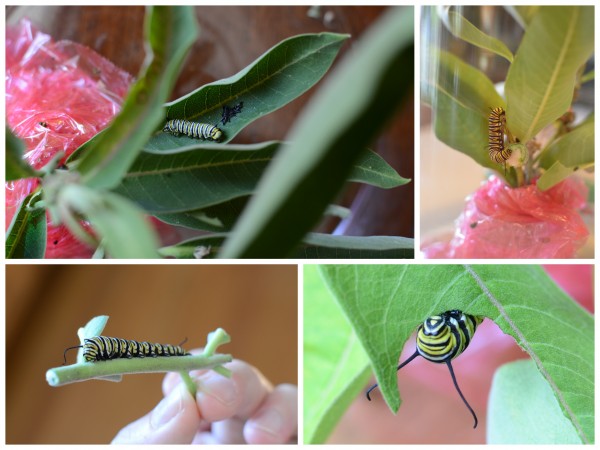
I found that keeping the stems in a small jar of water kept the leaves fresh enough to last a few days, since I had to drive to get leaves for them. One morning I woke up to this and had to go get more leaves before everyone was even out of bed!
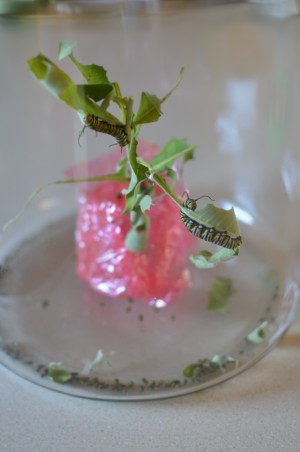
Finally the moment we’d been waiting for: Big Guy moved to the top of the container, attached himself and hung upside down in a “J” shape. We watched with excitement but ended up missing the moment of transformation into a chrysalis!
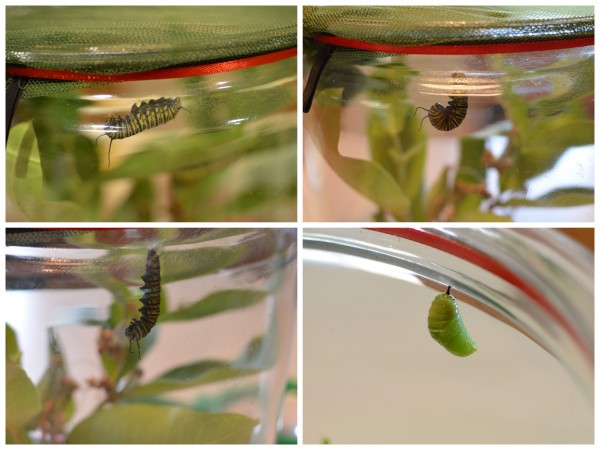
When it was Little Guy’s turn a couple days later my kids were determined not to miss it. I was afraid it would happen in the night and they didn’t want to go to bed. Mr. Tech Support (my husband) saved the day. He reminded me that the fancy camera he bought me can do time lapse photography, so we set it up to take photos all night long just in case. (Okay, maybe we’re crazy…but the kids were excited and I wanted them to sleep!)
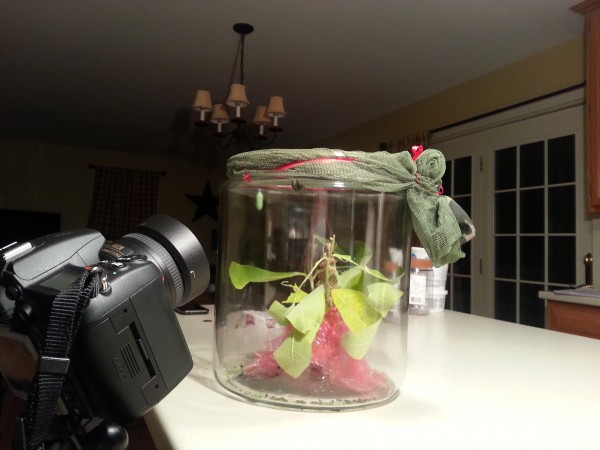
The caterpillar was still hanging in a J-shape the next morning so we set ourselves up to provide constant surveillance. I decided to keep the camera set up taking time lapse because it was really neat now that I’d figured out how to do it. (In fact, I may be taking time lapse photos of everything from science experiments to the cat napping. It’s fun!)
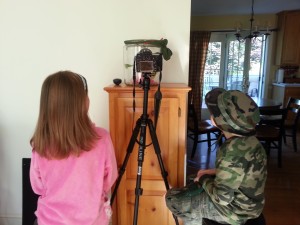
We made sure one of us had our eyes on it the whole time. Finally my daughter yelled and we witnessed the amazing transformation of this black, yellow, and white caterpillar with legs and antennae to a pale green chrysalis with a completely different shape. If you are interested here is my first amateur attempt at time-lapse photography:
We were amazed at the transformation, and how much the early pupae moved about to shed the old skin and attain its final form. Initially you could see the ridges from the caterpillar’s body and some striping, but the color changed and the chrysalis became more opaque. By the end it was a smooth, lovely shade of green. My favorite part are the markings that look like drops of gold paint. Truly amazing.
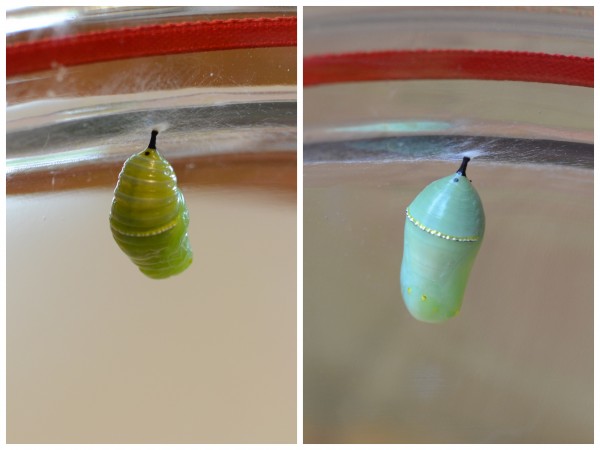
As we’ve been mesmerized by this process we’ve learned a lot about monarchs and butterflies in general using these resources:
- Real Science Odyssey Life Level One: Our new science curriculum had a unit on insects with specific labs about caterpillars and butterflies, so we did the corresponding lessons and journal pages. It meant working out of order but we had to work with nature on this one!
- Go-Along books:- It’s a Butterfly’s Lifeby Irene Kelly: This book has great information on all kinds of butterflies with beautiful drawings, and also fun facts about defense mechanisms and frass (both of particular interest to a six-year-old boy).- The Magic School Bus and the Butterfly Bunch: A good book for covering the life cycle of butterflies.- National Geographic Kids Great Migrations: Butterflies by Laura Marsh: This book has terrific photographs to illustrate the migration of monarch butterflies, a truly amazing feat.
- Magic School Bus episode “The Butterfly and the Bog Beast” (on our Bugs, Bugs, Bugs! DVD): The Magic School Bus show is a favorite around here. This episode gives great information on how butterflies are tough little creatures with many defenses.
- We used just about everything Barb put out for the Outdoor Hour Challenge on monarch butterflies. I highly recommend the You Tube vidoes on monarch migration–it really is an amazing journey! We enjoyed all of the links under “suggested resources to view or print” from learner.org. They have easy-to-understand information on monarchs and their annual cycle, and the link about wings was information we hadn’t read elsewhere. The corresponding information from the Handbook of Nature Study led to some microscope fun: we pulled out our pocket microscopes after I found these unfortunate guys in our garage.
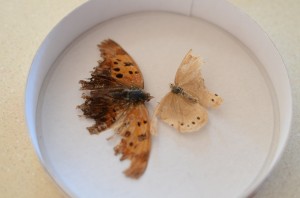 We’d read how the wings are covered with scales arranged in perfect rows, so it was wonderful to see for ourselves. It was also neat to read about the actions of the antennae when the caterpillar is frightened, something we’d observed when we spoke too loudly near the top of their glass container.
We’d read how the wings are covered with scales arranged in perfect rows, so it was wonderful to see for ourselves. It was also neat to read about the actions of the antennae when the caterpillar is frightened, something we’d observed when we spoke too loudly near the top of their glass container.
So now we anxiously await our butterflies. We think of Big Guy and Little Guy just under that green covering, preparing to become creatures that can fly. The transformation takes 10-14 days. This has been an amazing study, and for our family reinforced the wonders of God’s creation. I’ll be sure to update with photos when our butterflies emerge!
***Updated: Here is the post on our Monarch butterflies emerging and being released into nature!***
I’m submitting this to Barb’s Outdoor Hour Challenge Blog Carnival. Be sure to visit her site for nature study ideas, and watch for her blog carnival to see all the amazing summer nature study happening.
Our Homeschool Journal: a Fort, a Farm, and Family Fun
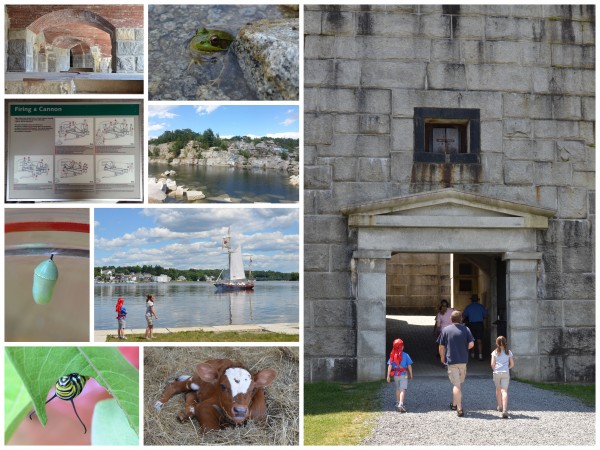
In our homeschool this week…
We finally hit our summer groove (I know, it’s almost time for heading back to school full time!): having lots of fun enjoying summer weather and activities, but still accomplishing the schoolwork that I had planned. The favorite at-home school activity was watching our monarch caterpillars form a chrysalis (much more to share about that in another post).
Places we’re going and people we’re seeing…
One thing I love about summer in Maine is the plethora of free or low-cost activities. Maybe it just seems like so many activities because our warm season is short and everyone is trying to fit things in! Anyway, we had a couple very educational days on the road this week. The first was “Pirate Day” at Fort Knox, a historic fort we usually visit each year anyway. An organization put on a show pretending to attack the fort under cannon fire. The pirate activities were fine, but my kids ended up having much more fun just exploring the fort: cannons, amazing stonework, passages you could get lost in, powder magazines…what’s not to love? A sign at the fort mentioned that the granite to build it came from a mountain nearby, so we drove there and hiked up to the quarry. It was amazing to see masses of granite and talk about how those square blocks of granite for the fort had been made. Plus the pond that formed in the excavation hole was home to some very cute frogs.
Another day was Open Farm Day in Maine, a day when farmers all over the state open their doors to the public for tours. We headed to an organic dairy farm, where the farmer was incredibly nice and filled our heads with what it’s like to run a small dairy farm including milking, making cheese and yogurt, and selling products at Farmer’s Markets. My summary: a whole lot of hard work.
My favorite activity this week was…
My favorite activity was most definitely being licked by a cute little calf at the dairy farm. Jo-Jo the calf was only about a month old, and for some reason loved licking us. This had us all in stitches, but I drew the line when Jo-Jo got to my elbow and began to nibble.
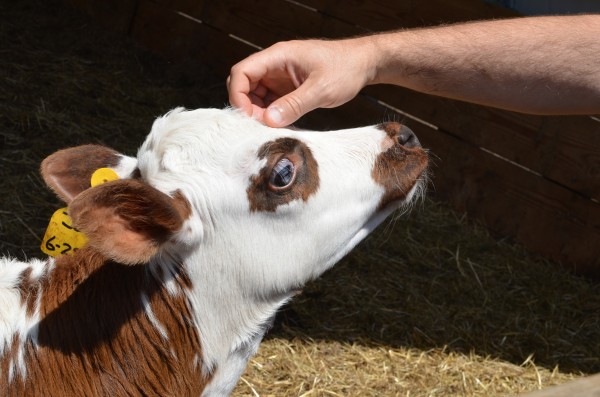
My favorite resource this week…
A new-to-me app called Mathopolis has both my kids practicing their math facts in their spare time. Really! Math facts during free time, isn’t that what homeschool moms dream about?
What’s working and not working for us…
Finally getting all the schoolwork I had planned for this week checked off my list (for the first time all summer) is completely working for me! I love lists, and especially love crossing things off. What’s not working is going to bed too late trying to catch up on my other lists.
Things I’m working on…
Finalizing next year’s curriculum is at the top of my to-do list. I’m SO close…just rethinking math and ironing out scheduling.
I’m reading…
The kids and I are reading the Little House series aloud together and right now we’re enjoying Farmer Boy. I’m going back through Home Learning Year By Year by Rebecca Rupp and Honey for Child’s Heart by Gladys Hunt as I formalize my plans for the year.
I’m grateful for…
A camping trip with my parents this weekend…and that there isn’t torrential rain in the weather forecast like there has been for our two other trips so far this summer. We love camping, and a trip with Grandma and Grandpa is double the fun!
Thank you to the wonderful hostesses with fun link-ups on Fridays. Be sure to join the fun and see what other homeschoolers are up to!
Review: Mathopolis App for Practicing Math Facts
I just have to share the new-to-me-app that I purchased last night. It may win the prize for the best educational app I’ve ever purchased. We’ve tried a few apps for math facts, and so far none have been a hit with my daughter. I sat down yesterday to try and find another app for my daughter to practice her multiplication facts. I am still a big fan of XtraMath, but I wanted a fun way for her to practice multiplication facts so when she gets to that level in XtraMath she will be able to progress quickly. I happened upon Mathopolis, and I am in love.
Mathopolis is a firefighter-themed app for practicing all math facts. We have an iphone, iPad and an iPod touch (all hand-me-downs, thanks to my husband’s tech-loving family) and this app works on all of them. On each device we can create multiple “firefighters,” which is especially helpful because you earn medals as you complete levels. You begin by choosing “play” to work on timed levels and earn medals, or “training” to be able to practice without being timed.
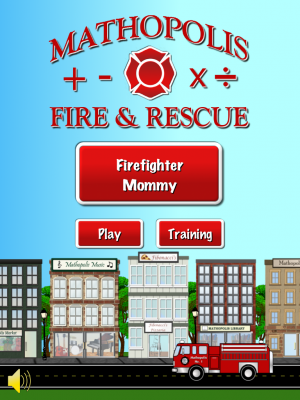
I love the many options in this app: just one operation at a time, or combinations of operations. Great practice!
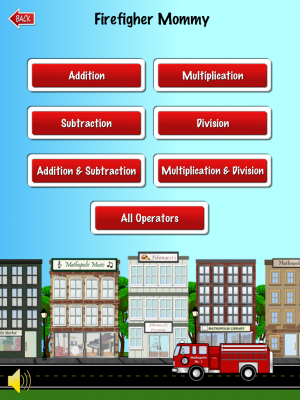
This is the “training” menu where you can choose which operation, which facts, and whether or not you want to be timed.
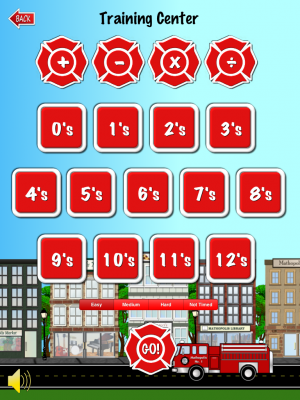
This playing menu shows any medals already earned. I like that there is a choice to practice all multiplication facts together.
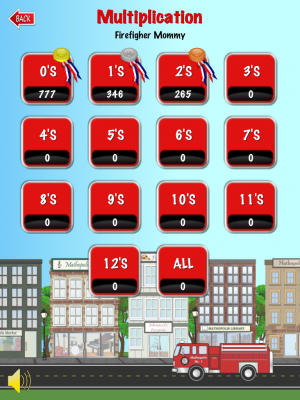
Here you see the screen while in play: a math fact appears, you touch the window with the answer before the clock runs out. Wrong answers mean you won’t earn a medal that round. You can even ask to see the missed problems at the end.
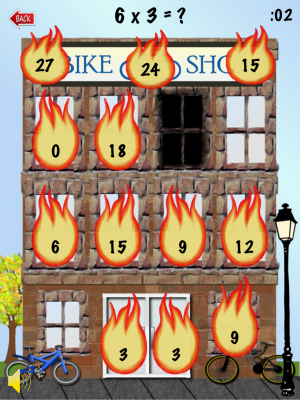
What we love:
This is an easy to use app that still provides lots of options for practicing math facts. The basic game is simple and nearly all the time is spent practicing facts. No time is wasted on other aspects of a game, or only doing the math facts to earn a separate, non-educational game. It is simple but both of my children love it. The biggest surprise: my daughter, who never chooses math as a “spare time” activity, picked up the iPad today to try to earn a few more medals. I’d have done a cartwheel if I didn’t worry I’d pull a muscle!
What we didn’t like:
Nothing. That’s a real rarity for me, as I’m usually quite picky about apps. I often don’t buy the in-app upgrades, and delete apps on a regular basis. Mathopolis is only 99 cents and is worth every penny!
Why I Was Wrong About the Kindle
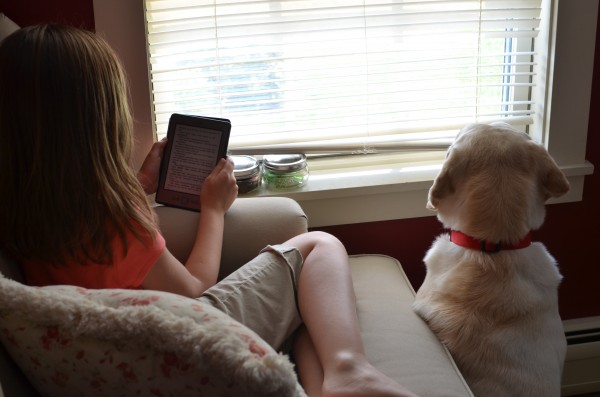
Conversations about incorporating new technology, be it software or hardware, in our house often go something like this:
My husband, fondly known as Mr. Tech Support: “Hey Heidi, I think you (or the kids) could benefit from [insert name of new technology here].”
Me: “No, no, I don’t think we need any new technology. In fact, there’s too much technology around here…whatever happened to the good old days where families grew all their own food and everyone sat around the wood stove at night? Those were simpler times. By the way, I’m thinking about getting chickens.”
Being the supremely patient husband that he is, he’ll just nod and smile. If he really thinks we should try it he’ll have a go at talking me into it again after I’m done looking at chicken coop plans online. This is when I launch into my litany of reasons why [insert name of new technology here] is actually evil. Again, he’ll smile smile and nod.
And…inevitably he’s right. I have fought everything from online banking to Google calendar to smartphones, all things I now couldn’t live without. Where does this fear come from? Maybe it’s hereditary: his grandmother was on Facebook and played poker on line while my grandmother never owned a computer. Perhaps I come from a long line of people with new-technology-phobia. Lucky for me (and my kids) I married a tech guru and he holds my hand all the way.
Back to the reason for this post: the Kindle. I fought this one for months and I felt like I’d accrued a pretty good list of reasons against getting one for our 10 year old daughter. Same routine: he’d mentioned it several times, I didn’t even research it but just said it was evil and would mean the death of all books (or something like that). I had my reasons against it and, as usual, it turns out I was completely wrong.
Reason number one (I was really proud of this one and used it first whenever the topic arose): “Oh, the eye strain!” This one is completely false. I had to see one in real life to be astounded by how an electronic screen can look just like a piece of paper. It doesn’t glow or have lighting or look like an iPad screen. It causes no more eye strain than reading a paper book for hours on end–something I was prone to do as a child.
My back-up reason: She won’t be reading real books, or quality literature. I was really off here. Okay, so it won’t be a paper book, but they are real books. And once we download them from most sources she can keep them on her kindle (it can store over a thousand books) so she can re-read them anytime. And here was the kicker: many older classic books are FREE so we were able to load her Kindle up with the good stuff. She’s already finished two classics that were on the list of books I wanted her to read. She is reading even more and instead of picking the newest looking book with a cute cover design at the library she’s picking up a classic. Bonus good point: she likes reading several books at once. With the Kindle she can bring those books with her camping or anywhere we go while taking up almost no space.
The last selling point, and something I hadn’t been open-minded enough to research and figure out, was the built-in dictionary. Yes, it’s valuable to be able to look up words in a paper dictionary, but who stops while reading a good book to do that? Well, on her kindle she just places her cursor over a word and sees the dictionary definition. She’s been telling us the meaning of words she has looked up, and we’re making it into a casual “word of the day” routine where she picks one for us all to try and use.
So, I was wrong. She’s not walking around with bloodshot eyes. She’s actually reading great books and enlarging her vocabulary all the while. Score another one for Mr. Tech Support.
Last Child in the Woods ~ Nature in our Homeschool
I’m here with my thoughts on Chapters 15-17 of the book Last Child in the Woods by Richard Louv. I’m participating in a book study hosted by Nicole of Journey to Excellence, be sure to visit her to read her thoughts on these chapters.
Chapter 15 discusses activities that offer a reason and focus for being in nature. Birding and nature journaling were two that we have enjoyed so far. Bird watching is one that my children and I had the pleasure of trying this past winter when we participated in the Great Backyard Bird Count. We prepared by learning about the birds in our area, then over the weekend of the GBBC we enjoyed our roles as scientists tallying birds and submitting our numbers to Cornell University. It occurs in the dead of winter here in Maine and it was great to have a nature-related activity to focus on. Nature journaling is another new-to-us activity mentioned in the book, and we’re all enjoying that through the recommendations of (once again) Barb at the Handbook of Nature Study blog. We often use her notebooking pages for some direction on what to draw. I have found that drawing an item really helps my children pay attention to the details.
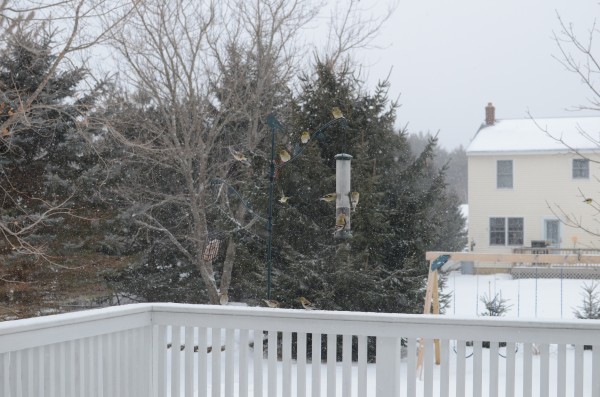
At the beginning of Chapter 16 when I read the statement that teachers should free kids from classrooms I said to myself–that’s my whole philosophy behind homeschooling! Not just so they can experience nature, but the world and its people and places. Then on page 211 there was a quote from a teacher: “This isn’t memorizing information for a test…this experience becomes part of you.” Hello! Again, this is the core of homeschooling for me. For me, school was about memorizing information for a test and then promptly forgetting it! I hope to show my kids a different experience.
This chapter discusses many hands-on nature programs and the success of the students in them. I was thrilled because many of the ideas mentioned are happening somewhere in our home right now–square foot gardening in the backyard, caterpillars growing fat on the kitchen counter, and tadpoles just beginning to get their legs on the deck. This is what science is all about for us at the elementary level: things that the kids can see and touch and be amazed at.
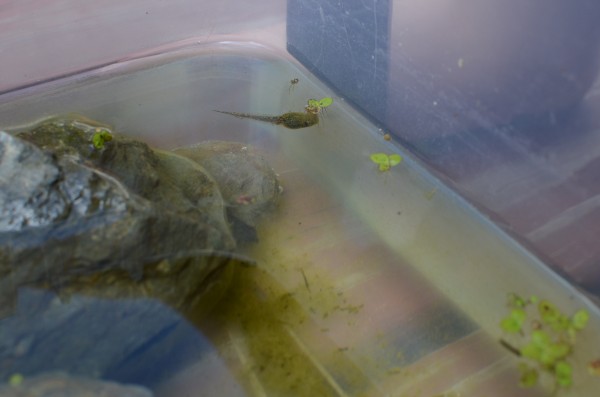
The last quote again hit me as a comment on homeschooling in general: “An environment-based education movement–at all levels of education–will help students realize that school isn’t supposed to be a polite form of incarceration, but a portal to the wider world.”
Chapter 17 talks about summer camps being a way to make nature more accessible to kids, and a lot of that discussion wasn’t really relevant for me. For our family, camping together at state parks provides the beneficial experiences and works for us while my kids are fairly young. We aren’t staying in a fancy camper with a bathroom, air-conditioning and television. It’s a pop-up with no plumbing, wooded campsites, and sleeping with the windows open.
I was interested in the author’s discussion of schools spending so much money on soon-to-be-obsolete electronics when they should spend it on natural areas where teachers can take their students to learn with all five senses. Case in point: our town just built a gigantic new high school surrounded by huge parking lots and athletic turf and running tracks. There is no natural area to spend time in, the library is smaller than before, and yet students will receive iPads to use. I also found out the other day that our middle school children have no recess at all. None. Parents were surprised that I thought this was sad! It didn’t seem to bother them that 12 year old kids don’t have time for recess or even 15 minutes of fresh air.
These chapters mark the end of the section of the book with ways to connect your children with nature at home and through their education. The next section is dedicated to ushering in what the author calls the “Fourth Frontier:” reconnecting our society as a whole with nature.



